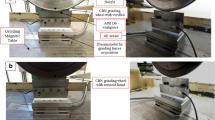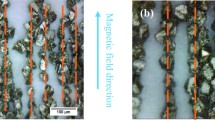Abstract
The purpose of this paper is to study a new high thermal conductivity vitrified bond CBN grinding wheel to improve the heat conduction rate during the grinding of titanium alloy. In order to analyze the effect of graphite addition on the properties of vitrified bond CBN grinding wheel samples, different amounts of graphite (0, 2, 4, 6 wt%) were added to the vitrified bonder. When the graphite addition is 2 wt%, the refractoriness, fluidity, and bending strength of the grinding wheel samples are better than those of conventional vitrified bond grinding wheel samples. The study found that the addition of graphite promoted the formation of pores in the grinding wheel samples after sintering, improved the chip-holding capacity of the grinding wheel, and thus improved the thermal conductivity of the customized grinding wheel. Finally, the vitrified bond grinding wheels with high thermal conductivity were successfully manufactured. Grinding titanium alloy (TC4) under the same experimental conditions showed that high thermal conductive CBN grinding wheels were better to conventional those in terms of grinding temperature and force, machined TC4 surface roughness. Thus, this study shows that high thermal conductivity vitrified bond CBN grinding wheels are more suitable for the grinding of titanium alloys.













Similar content being viewed by others
References
Boyer RR (1996) An overview on the use of titanium in the aerospace industry. Mater Sci Eng A 213:103–114. https://doi.org/10.1016/0921-5093(96)10233-1
Muszka K, Madej L, Wynne BP (2016) Corrigendum to “application of the digital material representation to strain localization prediction in the two phase titanium alloys for aerospace applications”. Arch. Civil Mech Eng 16:224–234. https://doi.org/10.1016/j.acme.2016.04.001
Rowe WB, Black SCE, Mills B (1996) Temperature control in CBN grinding. Int J Adv Manuf Technol 12:387–392. https://doi.org/10.1007/BF01186926
Xu X, Yu Y, Huang H (2003) Mechanisms of abrasive wear in the grinding of titanium (TC4) and nickel (K417) alloys. Wear 255:1421–1426. https://doi.org/10.1016/S0043-1648(03)00163-7
Chen Z, Xu J, Ding W, Ma C, Fu Y (2015) Grinding temperature during high-efficiency grinding Inconel 718 using porous CBN wheel with multilayer defined grain distribution. Int J Adv Manuf Technol 77:165–172. https://doi.org/10.1007/s00170-014-6403-5
Zhi G, Li X, Luo A, Yang J, Rong Y (2017) An experimental investigation on response of cBN super abrasive’s grinding performance and failure characteristics to the grinding speed. Exp Tech 41:117–130. https://doi.org/10.1007/s40799-016-0159-9
Yu T, Li H, Wang W (2016) Experimental investigation on grinding characteristics of optical glass BK7: with special emphasis on the effects of machining parameters. Int J Adv Manuf Technol 82:1405–1419. https://doi.org/10.1007/s00170-015-7495-2
Nadolny K, Sienicki W, Wojtewicz M (2015) The effect upon the grinding wheel active surface condition when impregnating with non-metallic elements during internal cylindrical grinding of titanium. Arch Civ Mech Eng 15:71–86. https://doi.org/10.1016/j.acme.2014.03.004
Yang C, Xu J, Ding W (2012) Grinding force in creep feed grinding of titanium alloy with monolayer brazed cbn wheels. Adv Mater Res 565:94–99. https://doi.org/10.4028/www.scientific.net/AMR.565.94
Wu J, Chen Y, Fu Y, Lan Y (2012) Experimental research on dry grinding of titanium alloy with graphite coated brazed cbn mounted wheel. Adv Mater Res 565:160–164. https://doi.org/10.4028/www.scientific.net/AMR.565.160
Azizi A, Rezaei SM, Rahimi A (2010) Study on the rotary cup dressing of CBN grinding wheel and the grinding performance. Int J Adv Manuf Technol 47:1053–1063. https://doi.org/10.1007/s00170-009-2227-0
Shan D, Li Z, Zhu Y, Zhu Y, Ye H, Gao K, Yu Y (2012) Influence of TiO2on the physical properties of low-temperature ceramic vitrified bond and mechanical properties of CBN composites. Ceram Int 38:4573–4578. https://doi.org/10.1016/j.ceramint.2012.02.035
Tsai MY, Jian SX (2012) Development of a micro-graphite impregnated grinding wheel. Int J Mach Tools Manuf 56:94–101. https://doi.org/10.1016/j.ijmachtools.2012.01.007
Wu Y, Shen M, Qu M, Qu M, Xie C, Shang Z, Jing T (2019) An experimental investigation on surface layer damage in high-efficiency and low-damage grinding of rail by slotted CBN grinding wheel. Int J Adv Manuf Technol 105:2833–2841. https://doi.org/10.1007/s00170-019-04528-x
Lee KW, Wong PK, Zhang JH (2000) Study on the grinding of advanced ceramics with slotted diamond wheels. J Mater Process Technol 100:230–235. https://doi.org/10.1016/S0924-0136(00)00403-9
Damasceno RF, Ruzzi R d S, França TV et al (2017) Performance evaluation of various cooling-lubrication techniques in grinding of hardened AISI 4340 steel with vitrified bond CBN wheel. Int J Adv Manuf Technol 92:3795–3806. https://doi.org/10.1007/s00170-017-0434-7
Shi Y, Wang Z, Xu S, Yu T, Sun Z (2019) Study on the grindability of nano-vitrified bond CBN grinding wheel for nickel-based alloy. Int J Adv Manuf Technol 100:1913–1921. https://doi.org/10.1007/s00170-018-2807-y
Dewar S, Bauer R, Warkentin A (2018) Application of high-angle helical-grooved vitrified wheels to cylindrical plunge grinding. Int J Adv Manuf Technol 96:2443–2453. https://doi.org/10.1007/s00170-018-1801-8
Nadolny K, Herman D (2015) Effect of vitrified bond microstructure and volume fraction in the grinding wheel on traverse internal cylindrical grinding of Inconel® alloy 600. Int J Adv Manuf Technol 81:905–915. https://doi.org/10.1007/s00170-015-7013-6
Nadolny K (2015) Wear phenomena of grinding wheels with sol–gel alumina abrasive grains and glass–ceramic vitrified bond during internal cylindrical traverse grinding of 100Cr6 steel. Int J Adv Manuf Technol 77:83–98. https://doi.org/10.1007/s00170-014-6432-0
Wang C, Zhang F, Pan J, Mao J, Long Y, Huang H, Wang C, Lin H, Deng X, Wu S (2017) An experimental study on preparation of vitrified bond diamond grinding wheel with hollow spherical corundum granules as pore former. Int J Adv Manuf Technol 93:595–603. https://doi.org/10.1007/s00170-017-0475-y
Caggiano A, Teti R (2013) CBN grinding performance improvement in aircraft engine components manufacture. Procedia CIRP 9:109–114. https://doi.org/10.1016/j.procir.2013.06.177
Zhao B, Li Z, Zhu Y (2013) Effect of polycrystalline mullite fibers on the properties of vitrified bond and vitrified CBN composites. Ceram Int 39:2863–2868. https://doi.org/10.1016/j.ceramint.2012.09.059
Yang X, Bai J, Jing W, Wang B, Yang J (2016) Strengthening of low-temperature sintered vitrified bond cBN grinding wheels by pre-oxidation of cBN abrasives. Ceram Int 42:9283–9286. https://doi.org/10.1016/j.ceramint.2016.02.070
Tanaka T, Esaki S, Nishida K, Nakajima T, Ueno K (2004) Development and application of porous vitrified-bond wheel with ultra-fine diamond abrasives. Key Eng Mater 257–258:251–256. https://doi.org/10.4028/www.scientific.net/KEM.257-258.251
Sadeghi MH, Haddad MJ, Tawakoli T, Emami M (2009) Minimal quantity lubrication-MQL in grinding of Ti-6Al-4V titanium alloy. Int J Adv Manuf Technol 44:487–500. https://doi.org/10.1007/s00170-008-1857-y
Sun X, Yu T, Wang X, Xu M, Wang W (2018) Effect of TiO2 addition and high magnetic field sintering on properties of vitrified bond CBN composites. Ceram Int 44:16307–16313. https://doi.org/10.1016/j.ceramint.2018.06.030
Kim H, Ryu S, Kim S, Kim H (2009) Mechanical properties of new vitrified bonds for cBN grinding wheel. Int J Precis Eng Manuf 10:13–17. https://doi.org/10.1007/s12541-009-0041-0
Shi Z, Malkin S (2006) Wear of electroplated CBN grinding wheels. J Manuf Sci Eng 128:110. https://doi.org/10.1115/1.2122987
Thangarasu A, Murugan N, Dinaharan I, Vijay SJ (2015) Synthesis and characterization of titanium carbide particulate reinforced AA6082 aluminium alloy composites via friction stir processing. Arch Civ Mech Eng 15:324–334. https://doi.org/10.1016/j.acme.2014.05.010
Pratap A, Patra K, Dyakonov AA (2019) A comprehensive review of micro-grinding: emphasis on toolings, performance analysis, modeling techniques, and future research directions. Int J Adv Manuf Technol 104:63–102. https://doi.org/10.1007/s00170-019-03831-x
Xi X, Ding W, Li Z, Xu J (2017) High speed grinding of particulate reinforced titanium matrix composites using a monolayer brazed cubic boron nitride wheel. Int J Adv Manuf Technol 90:1529–1538. https://doi.org/10.1007/s00170-016-9493-4
Zhou X, Xi F (2002) Modeling and predicting surface roughness of the grinding process. Int J Mach Tools Manuf 42:969–977. https://doi.org/10.1016/S0890-6955(02)00011-1
Ding W, Zhang L, Li Z et al (2017) Review on grinding-induced residual stresses in metallic materials. Int J Adv Manuf Technol 88:2939–2968. https://doi.org/10.1007/s00170-016-8998-1
Author information
Authors and Affiliations
Corresponding author
Additional information
Publisher’s note
Springer Nature remains neutral with regard to jurisdictional claims in published maps and institutional affiliations.
Rights and permissions
About this article
Cite this article
Shi, Y., Chen, L., Xin, H. et al. Investigation on the grinding properties of high thermal conductivity vitrified bond CBN grinding wheel for titanium alloy. Int J Adv Manuf Technol 107, 1539–1549 (2020). https://doi.org/10.1007/s00170-020-05134-y
Received:
Accepted:
Published:
Issue Date:
DOI: https://doi.org/10.1007/s00170-020-05134-y




